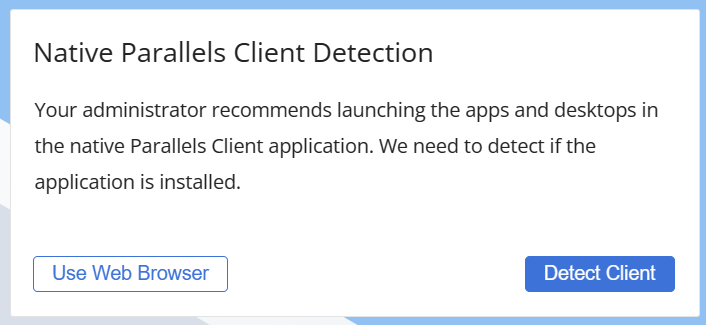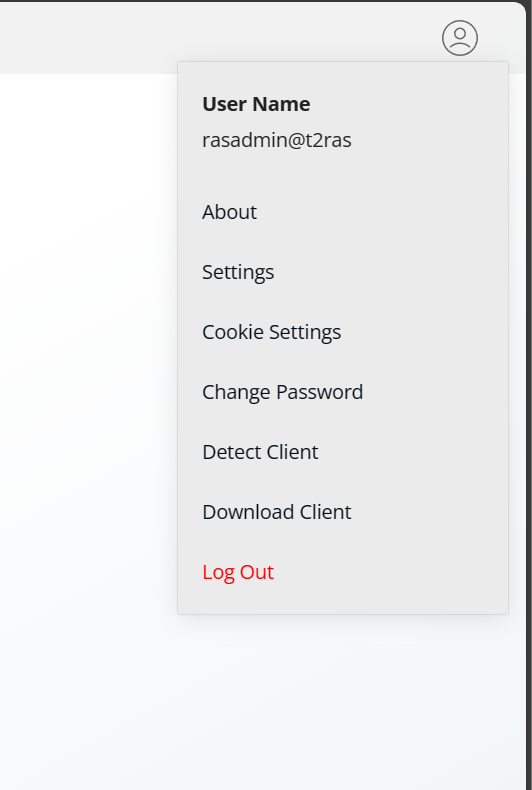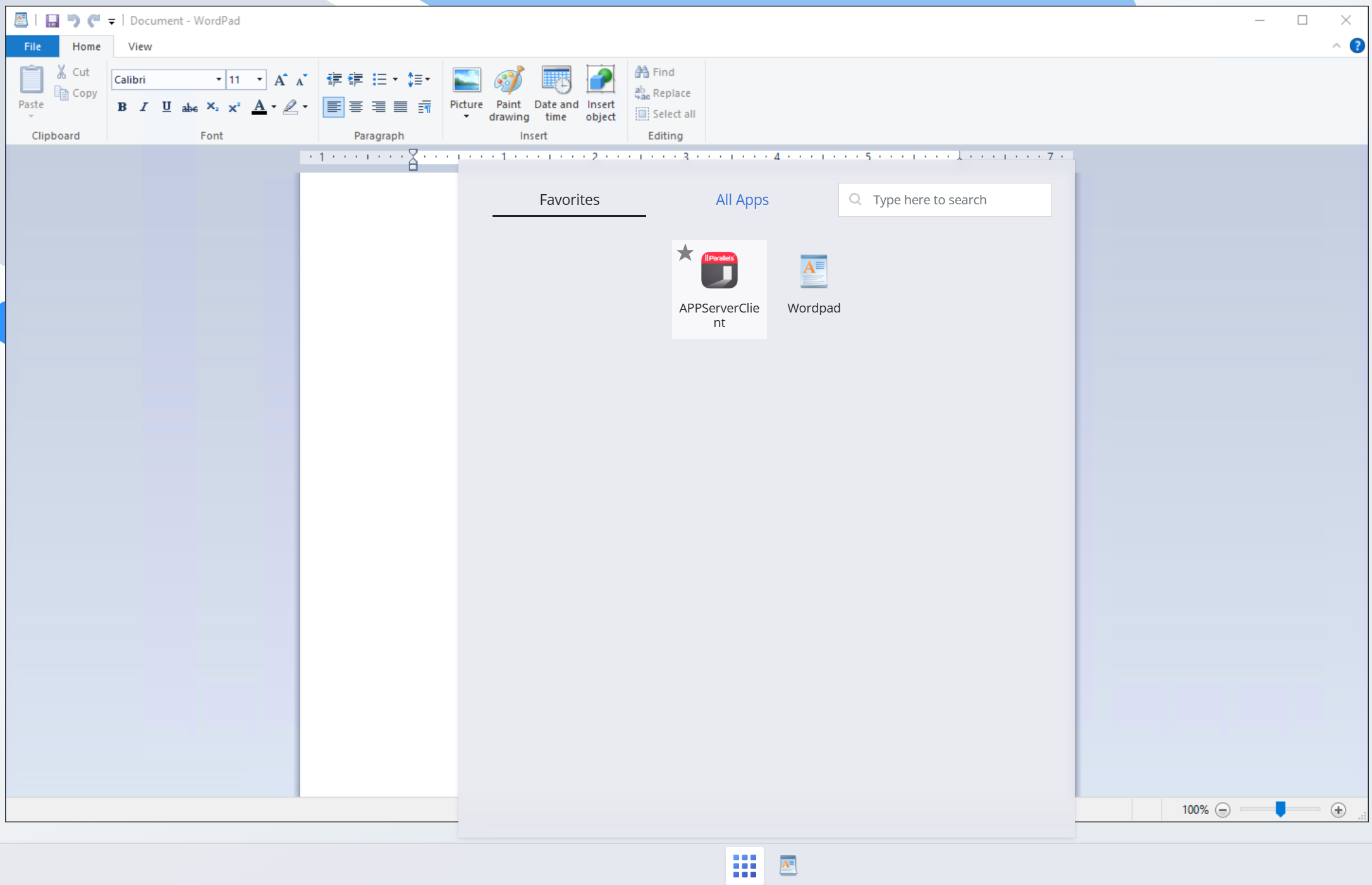The Parallels Client for Web is a Remote Application Server client application that runs inside a web browser. End users can use Parallels Client for Web to view, launch, and work with remote applications and desktop in a web browser. The Parallels Client for Web does not require end users to install additional software on their devices, therefore it is not platform-specific.
The only requirement to use Parallels Client for Web is an HTML5-enabled web browser that must be installed on a client device.
Open Parallels Client for Web
To open Parallels Client for Web in a web browser, enter one of the following in a web browser, depending on your setup:
- The DNS name of an HALB device or HALB Virtual Server (if in use). For example, https://ras.msp.com.
- The FQDN or IP address of a specific Remote Application Server Secure Gateway. For example, https://ras-gw1.company.dom.
When you open the URL in a web browser, the login page is displayed.
Once the user is logged in, one of the scenarios described below takes place depending on how the Parallels Client for web is configured on the server-side.
Launching apps in Parallels Client and fallback to Browser
With this option configured on the server side, you will see a dialog box in the web browser with the following options:

- Use Web Browser. Closes this dialog box and opens the main Parallels Client for Web screen. Remote applications or desktops will be launched in the web browser. When you open Parallels Client for Web the next time, you will again see the same dialog box with the same options.
- Detect Client. Parallels Client for Web will try to detect whether Parallels Client is installed on the client device.
If Parallels Client is not detected, a new dialog box will be presented:

- Use Web Browser. Closes this dialog box and opens the main Parallels Client for Web screen. Remote applications or desktops will be launched in the web browser. When you open Parallels Client for Web the next time, you will again see the initial dialog box.
- Install Client. Opens the Parallels Client download and installation page.
After the installation, you should see Parallels Client for Web displaying published resources that you can use.
You can now run remote applications and desktop in Parallels Client or in a browser (Parallels Client for Web). The default method for running applications and desktops is Parallels Client. To run a remote application or desktop in a browser, right-click it (or tap and hold on a mobile device) and then choose "Open in this tab".
Launch apps in Parallels Client Only
When this option is configured on the server-side, you will see a dialog box prompting you to install Parallels Client. Click the link provided to open the Parallels Client download and installation page and follow the instructions. After you install Parallels Client, the main Parallels Client for web screen opens displaying published resources that you can use. If you now double-click or tap a resource, it will be launched in Parallels Client.
Launch apps in Browser Only (Parallels Client for Web only)
With this option configured, the main Parallels Client for Web screen opens with no additional prompts. Remote applications and desktops will be launched in the web browser.
Main Menu Options
To open the Parallels Client for Web main menu, click or tap the "person" icon in the upper right. You can select from the menu options described below.

About
Displays information about Client ID and Parallels Client for Web version.
Settings
Allows you to configure the following settings:
- Local resources:
- Clipboard. "Bidirectional", "Server to client only" and "Client to server only" are allowing redirection of the clipboard in the respective directions. Only plain text is supported in Parallels Client for Web.
- Sound. To play the sound on the local computer, select the Bring to this computer option. If sound is not supported by your browser, the menu will be disabled and you'll see a corresponding text message below it.
- Audio recording. Enables or disables the sound input redirection from the local computer to the remote application. For example, if you would like to use a microphone in Skype or a similar app for teleconferencing, you need to enable audio recording in the Parallels HTML5 client. Select Record from this computer to enable recording or select Do not record to disable it.
- Redirect links. Select a desired redirection option from the following: Do not redirect, Redirect URLs, Redirect email, Redirect all. When redirection is enabled, a link will be opened on the local computer.
- Redirect Printers. Select a printer redirection option: Remote Application Server Universal Printer (creates a virtual printer on the remote host, which upon print will open Web Browser printing dialogue allowing to print on the local printer) or Do not redirect (printers will not be redirected).
- Input:
- Pen and touch input. Enable or disable pen input redirection with pressure sensitivity support. Please note that the eraser button is not supported.
- Keyboard mode. Select Universal Keyboard or PC Keyboard. If you have problems typing certain characters, try selecting PC Keyboard and then selecting a proper layout in the Keyboard Layout drop-down list.
- Keyboard layout. Select a keyboard layout (e.g. English (US), English (UK), Japanese). To enable this drop-down list, the Keyboard Mode option must be set to PC Keyboard.
- Connection:
- Auto login. : Enable or disable auto login in User Portal. If this option is on, and the user credentials have been saved before, the user will not have to enter them again. This option may not be available if a Client Policy was applied where this option is turned off. Note that the auto login option is supported on the latest Chromium-based browsers, such as Google Chrome and Microsoft Edge.
- Connection timeout. Specify the connection timeout in seconds.
- MFA - remember last method used. : If using multi-factor authentication, enable this option so the last method used is remembered and used by default
- Always ask for credentials when starting applications. : If this option is enabled, a user will be asked to enter credentials when starting an application even if the session is still active. You can use this option as added security to prevent unauthorized users to access applications.
- Launch items in. Allows to configure preferred method of launching published resources.
Cookie Settings
Provides information about privacy and user-information stored by Parallels Client for Web, allows to disable Analytics Cookies.
Change Password
Allows the user to remotely change their domain password. When the password is being changed, the password requirements are displayed on the screen, so the user can follow them for the new password to be accepted. This option can be disabled through Client Policies (Control settings > Password > Prohibit changing password)
Detect client
Determines if Parallels Client is installed on the local computer. If Parallels Client is not installed, gives user an option to install it.
Download Client
Opens a web page with instructions on how to download and install Parallels Client.
Logout
Ends user session with Parallels Remote Application Server and logs the user out
Running Remote Applications and Desktops
To launch a remote application or desktop in User Portal, do one of the following:
- Double-click (or tap on a mobile device) an application or a desktop icon. The resource will open inside a web browser or in Parallels Client depending on the server-side User Portal configuration (Remote Application Server Secure Gateway Properties > User Portal > Launch sessions using option or based on the Settings > Connection > Launch items in option of the Parallels Client for Web setting, with server-side configuration having priority over Parallels Client for Web setting).
- Right-click (or tap and hold on a mobile device) an application or a desktop to display a context menu. The menu will appear if the Allow user to select launch method or Allow opening applications in a new tab (or both) options are selected on the Remote Application Server Secure Gateway Properties > User Portal tab in the Remote Application Serverconsole. The menu allows you to choose whether to open the resource in Parallels Client or Parallels Client for Web (depending on the setting mentioned above) and it also allows you to choose whether to open an application in the same or new tab in the web browser.
- If a resource cannot be opened in Parallels Client due to an error, a message will be displayed with an option to open it in the web browser instead.
Using drag and drop functionality
Parallels Client for Web supports drag and drop functionality when running remote applications and desktops.
Here's how to use drag and drop when working with a remote application:
- Select a file on your local computer
- Drag and drop the selected file to an app. The 'Save as' window will pop up.
- Enter a name for the file and save it. The file will be saved on the server hosting the app
You can also drag and drop files between two remote apps running on different hosts. Here's how to use drag and drop with a remote desktop:
- Select a file on your local computer
- Drag and drop the selected file to a remote desktop. The 'save as' window will pop up
- Enter a name for the file and save it. The file will be saved on the desktop on the server that hosts it
Other useful features
Other useful functionality on the main Parallels HTML5 Client screen includes the following:
- Favorites list. You can add a remote application or a desktop to the Favorites list, so you can easily find them. To do so, point to or tap an application or a desktop and then click or tap the "star" icon next to them. To view the list, click or tap the "Favorites" menu option. To remove a resource from the list, point to it and click the "star" icon.
- Search. To search for a resource, begin typing its name in the Search box (upper right). The list will be filtered as you type to contain only the resources with matching names.
- View a description. To view a resource description, position the mouse pointer over it. The description will appear as a tooltip. This could be helpful if one or more resources are published using the same name. By reading the description, you can distinguish between them.
- Taskbar. When you launch a remote application or a desktop, its icon is added to the taskbar at the bottom of the screen. When the taskbar is full, items of the same type are grouped to save space. You can click or tap on a group to see the list of all running instances and to switch to or close a particular instance.

Was this article helpful?
Tell us how we can improve it.